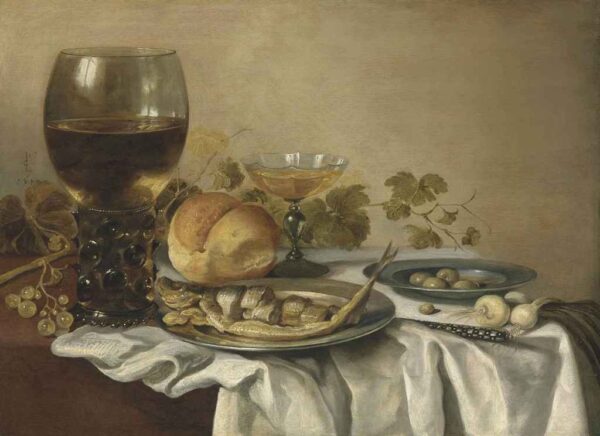
The golden age of Dutch art coincided with that nation’s high water mark as a commercial powerhouse. In the first half of the seventeenth century, its merchant navy dwarfed England’s. The French, at that point, weren’t even in the running – though they saw the danger and began frantically planting the oak forests they would need to create a fleet worthy of the name (more on that in a bit).
And what were the Dutch up to with all those ships? Well, there was the lucrative traffic in spices and other luxury goods from the trading outposts they had established in what is today Indonesia. They had also muscled their way into the commerce in expensive sweet wines from the eastern Mediterranean, once the exclusive province of the Venetians, whose fabulously lucrative monopoly on such goods was on the wane. The journeys to and from these far flung ports were so long, and the expense involved so great, that there was no point in meddling with wine that wasn’t gem quality.
But the canny Dutch weren’t the sort to leave money on the table, and when they spied an opportunity to service the demand for rough, ordinary, tavern-quality wine, they leapt at it. Their unmatched expertise in draining wetlands was put to work in Bordeaux where swaths of heretofore unproductive land was brought under vine. Peasant smallholders upstream were convinced to plant more white varietals by a promise to buy all they produced. In the coastal areas north of Bordeaux, the Dutch encouraged the making of cheap white wines that could be stabilized for shipment with a trick they had learned in the Rhineland – the burning of sulfur matches to sterilize barrels and keep wine from going off en route to customers.
In the forested regions of Cognac and Armagnac – where wine had never been a significant contributor to the economy – the Dutch built pot stills fired by local hardwood. Some of the world’s greatest brandies owe their reputations to this original initiative. In the same period, Dutch influence played a major role in the nativity of the luxuriously sweet wines of Sauternes, Barsac and the Loire’s Coteaux du Layon.
There’s more. Dutch successes and ruthless behavior left a bad taste in the mouths of rivals they seemed always one step ahead of. Resentment and fear generated a backlash that saw both France and Britain making substantial reinvestments in their fleets and stimulated them to make the most of at-hand commercial opportunities. For France, this meant more attentiveness to its native wine industry; for Britain, a search for new sources of wine, which led directly to the development of trade with (and an expansion of winegrowing in) Spain and Portugal. Modern European wine, it seems, had a Dutch uncle.
As for those forests, the age of sail may be a thing of the past, but the forests France planted out of fear of Netherlandish maritime hegemony are still proving their worth — as important sources of oak for the barrels that mature some of the world’s most sought-after wines.
–Stephen Meuse
Taste, talk, and learn about wine this week in the FKC wine corner . . .
THURSDAY, MAY 23 3-6 PM – AGE OF SAIL
2017 Laurent Bannwarth Alsace Pinot Gris “Tradition,” $22.95
2018 Mas de Gourgonnier Les Baux de Provence Rosé, $19.95
2017 Monte Bernardi “Retromarchia” Chianti Classico, $23.95
FRIDAY, MAY 24 3-6 PM – MERCHANT ADVENTURERS
2017 Vadiaperti Falanghina del Beneventano, $18.95
2018 Les Têtes, Touraine Rosè, $17.95
2016 Domaine Montirius, Vacqueyras “Garrigues,” $25.95